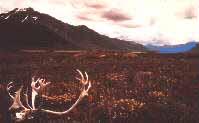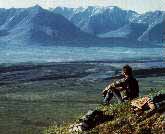 Park Details
Park Details
 Go to Park Details
Go to Park DetailsSome of the most important aspects of wilderness are its intangible qualities. Space is critical - space for animals to roam and for people to wander. Another critical element is the dominance of the forces of nature, allowing almost no evidence of human activity. The most elusive benefits of wilderness are in the minds of people - feelings of solitude, freedom, discovery, adventure, challenge, self-reliance - essential products of the wilderness experience that have always been a part of American culture.
The national park system comprises over 300 areas of special importance to the people of the United States - a system that includes superlative natural, historical, scientific, and recreational areas in every region of the country. Within this broad spectrum of resources and opportunities, Gates of the Arctic National Park is distinguished by its special wilderness purposes. Gates of the Arctic encompasses several congressionally recognized elements, including the national park, national preserve, wilderness, and six Wild Rivers. The National Park Service is entrusted to manage this area to protect its physical resources and to maintain the intangible qualities of the wilderness and the opportunity it provides for people to learn and renew its values.
Proclaimed Gates of the Arctic National Monument Dec. 1,
1978.
Established as a national park and preserve Dec. 2, 1980.
Wilderness designated Dec. 2, 1980.
Designated a Biosphere Reserve 1984.
Acreage:
National
park: 7,253,888
Federal: 7,281,654.48
Nonfederal
242,233.52
National preserve: 948,629
Federal:
948,504
Nonfederal: 125
Total Park and Preserve area: 8,202,517
Wilderness area: 7,052,000
 Park Details
Park Details
Location Information
Location
Central Brooks Range, about 200 miles northwest of
Fairbanks
Addresses:
Operating Hours/Seasons
The Park and Preserve are open year round.
Reservations/Permits/Fees
No admission or user fees for non-commercial users.
The park will be initializing a required backcountry orientation program for all recreational travelers in 1997. The backcountry orientation will be offered at the: Bettles Ranger Station, Coldfoot Visitor Center, and Anaktuvuk Pass Ranger Station. Backcountry users not passing through one of these locations should call the Bettles Ranger Station.
Climate, Recommended Clothing
The central Brooks Range has long severe winters and relatively short cool summers. The entire region receives continuous sunlight during the summer for at least 30 days.
The south side of the Brooks Range below 2500 feet is generally a sub-arctic climate zone. Precipitation is low, averaging 12-18 inches in the west and 8-12 inches in the east. The average maximum and minimum July temperatures are 70F and 46F, respectively. Thunderstorm activity is common during June and July.
Generally June through September is the wettest time of year. Prevailing winds are out of the north. Freezing temperatures may occur at any time of the year, but particularly from mid-August on. July may be the only month that snow does not fall.
Winter is extreme, long and cold. Snow falls 8 or 9 months of the year, averaging 60-80 inches. Average minimum and maximum January temperatures are -10F and -30F.
Facilities and Opportunities
Visitor Center/Exhibits:
The Anaktuvuk Pass Ranger Station, Bettles Ranger Station, and Coldfoot Visitor Center have backcountry orientation displays. Bettles Ranger Station has an interactive CD-ROM program on site. The Coldfoot Visitor Center has scheduled evening programs during the summer.
Trails/Roads:
There are no roads or established trails within the Gates of the Arctic. Hikers should practice Leave No Trace techniques, be aware of backcountry safety guidelines and remain aware of the fragile ecosystems and private land within the park.
Accessibility
Gates of the Arctic is a remote wilderness, and travelers
should be fully competent in outdoor skills. Administrative
buildings in Fairbanks, Anaktuvuk Pass, Coldfoot and Bettles are
accessible.
Programs/Activities:
As mentioned the Coldfoot Visitor Center offers evening programs during the summer. While in Coldfoot check out the ruins and cemetery of "Old Coldfoot" or visit the historic village of Wiseman just 13 miles up the road.
Lodging and Camping:
There is no commercial lodging in the park. Commercial facilities exist in Anaktuvuk Pass, Bettles, Coldfoot, and Wiseman. There is also a campground managed by BLM at Dalton Highway Milepost 180 (5 miles north of Coldfoot). The campground is open from June through mid-September. It is the responsibility of the visitor to obtain all of the necessary information and avoid private property.
Food/Supplies
Supplies are generally not available within the Park. Visitors must plan to be self-sufficient.
Recommended Activities/Park Use
Gates of the Arctic is one of several conservation units located in the Brooks Range. Many of these units were established for wilderness recreation activities such as: backpacking, river running, mountaineering, dog mushing, and others. The remote location and extreme climate of the Brooks Range requires travelers to have strong wilderness skills and flexibility to adjust plans. The Dalton Highway offers a road accessible Brooks Range experience for those not prepared for a rugged wilderness journey.
Visitation
Visitation averages 4,000 recreational visits per year. One Alaska Native community is located within the boundary of the park, and its residents and those of eight other adjacent communities use the park for subsistence hunting, fishing, trapping, and gathering.
Basic Visit Recommendations:
Visitors are strongly encouraged to practice minimum impact/ leave no trace camping guidelines at all times. Fires should be used only when regulations permit and if possible, kept on river bars below the high water line.
Visitors are reminded there are no facilities within the preserve and they should be self-sufficient at all times.
Visitor Impacts:
The backcountry eco-systems of Interior Alaska are very fragile. Visitors should be aware of delicate areas when selecting campsites. Gravel and sand bars offer ideal campsites; they afford breezes which deter insects and allow optimal views, thus discouraging surprise encounters with wildlife. These sites flood during high-water each spring, washing away all signs of impact.
Three areas within the park are considered wilderness concerns due to occasional levels of high use. Care must be taken in selecting a campsite in these areas. They are the Arrigetch Peaks, Noatak River, and the North Fork of the Koyukuk. See the expanded webpages for more details
State hunting and fishing guidelines and regulations must be followed. Sport hunting is allowed in the Preserve areas of Gates of the Arctic NP&P. Collection of any artifact is prohibited.
Adjacent Visitor Attractions
The Dalton Highway Utility Corridor is administered by BLM. Kanuti National Wildlife Refuge and Arctic National Wildlife Refuge are administered by the US Fish & Wildlife Service. Cape Krusenstern National Monument, Kobuk Valley National Park, and Noatak National Preserve are administered by the National Park Service.
Additional Information
The Visitor Center at Coldfoot is an interagency service, operated cooperatively by the Bureau of Land Management (BLM), US Fish & Wildlife Service (USF&S), and the National Park Service (NPS).
Back to Park Details List
Top of Page
National Parks Home